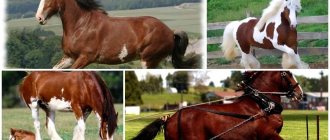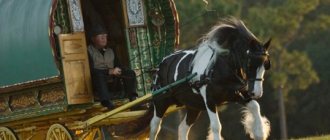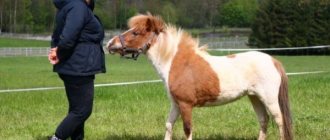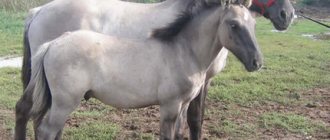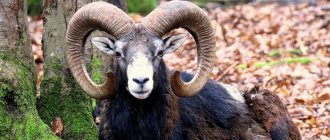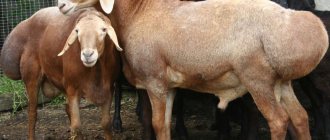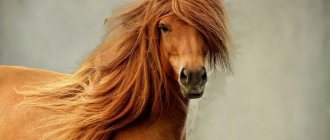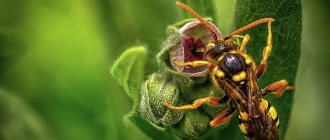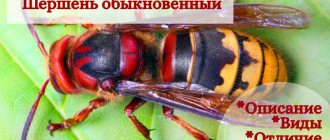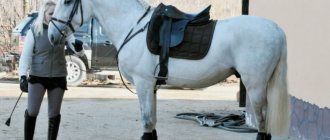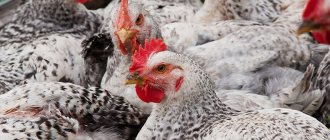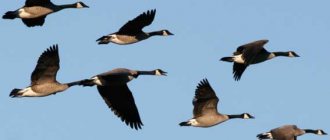Experts believe that there are no pure wild horses left in the modern world. Free-ranging “wild horses” live in national parks and are under human care. In severe winters they are provided with hay, and in drought they are provided with a watering hole. However, keepers try to minimize contact with the horses so that they retain the distrust of humans characteristic of wild animals.
A little historical background
It is assumed that the breed was formed over the course of a century. The roots come from domestic horses.
The fact is that during the development of territories, people often abandoned sick animals, and horses also ran away from pastures.
Naturally, no one was going to look for them; this was a pointless exercise, given the vastness of the prairies.
Animals gathered in herds and roamed in search of water and food. Some individuals died. Those that survived learned to live without humans.
Endangered breeds
Russia at the beginning of the twentieth century was one of the most equestrian countries in the world. Having a wide variety of natural conditions, it also had a sufficient number of horse breeds adapted to specific areas. However, time and technological progress have driven the horse out of most areas of everyday life: 22% of horse breeds have already disappeared, and the numbers of 29% of breeds are either at the lower threshold of possibility of conservation, or their existence is generally questioned.
Entire layers of the history and culture of the regions and nationalities living in them are associated with indigenous breeds. The disappearance of breeds threatens the loss of national traditions and national self-identification. This truth was realized at least in Bashkiria, Tuva, Buryatia, Yakutia, where the preservation of the traditional way of life is directly related to horse breeding. Horses are used here both as labor and as a source of meat, milk, and six. In these regions, there are national programs to support horse breeding, but in general the number of horses here is quite large and does not cause concern for their continued existence.
The situation is much worse with the Mezen breed, Pechora, Priobskaya, Tavdinskaya, etc. These are horses mainly for working purposes. With the widespread introduction of mechanization in rural and private farms, the need for horsepower has sharply decreased. However, along with the disappearance of horses from villages and villages, employment decreases, folk traditions and crafts are lost, and social problems increase. So maybe national breeds and their preservation are one of the “links” of Russian society, not far-fetched, but quite real?
Mezen breed. One of the northernmost Russian breeds. Unpretentious to feed, able to walk in deep snow, these hardy horses were faithful helpers of Pomors. Now there are no more than 500 individuals left. Photo: Natalya Spasskaya, Kommersant
Extermination
In the 19th and 20th centuries, these magnificent animals were killed for meat and skins. During the First World War, most of the livestock was destroyed.
But even after this, their numbers continued to decrease. The reason was the small amount of grazing land.
In 1971, American authorities banned hunting of wild animals. Today the number of mustangs is no more than 20 thousand.
Tarpans
The first wild horses to live in Europe were tarpans. They were divided into inhabitants of the steppe and forest parts. They lived mainly in groups, led by the most active stallions. Externally, the tarpan looked like a small horse (taller than a pony); at the withers, the animal reached a size of 136 cm. You can see what the tarpan looked like in the photo below.
The European wild horse (the second name for tarpans) was of a mouse color, that is, black-brown or yellow with a brown tint. The mane was protruding, short, and dark, as was the tail. The tarpan's hooves were very dense and strong. Thick and dense wool prevented these inhabitants of Eastern Europe from freezing in winter. In winter, this wild horse lightened, becoming a sandy color. Herds of hundreds of heads could run long distances, dividing into smaller groups along the way.
Color
In various photos of wild horses you can see the variety of colors of the breed.
Almost half of all horses are red-brown. The rest are gray-brown, gray, black. White with various inclusions.
Note!
- Animals of the Red Book of Russia: complete list of animals, photo, name, description
- A Guide to Fish Oil and Omega-3
- Koala: photo, lifestyle, habitat, habits, character, types, interesting facts
The Indians preferred spotted or camouflaged mustangs. By the way, they tried to improve the breed. These beauties are 1 m 60 cm tall and weigh 340 kg.
Donkeys
There are two groups of donkeys: Asian and African. Asian half-donkeys are a cross between a donkey and a horse. With their light body, they more closely resemble a horse, but their voice is more like the cries of a donkey than the neighing of a horse. Today, many subspecies of half-donkeys live in Asia and the Middle East: the Mongolian kulan, fast and hardy, the Tibetan kiang, adapted to high-mountain living conditions, the Indian onager, jigetai, khur. The ancestor of the domestic donkey is the Nubian wild ass, which still lives in the bleak, rocky deserts of Africa.
It is perfectly adapted to life in a hot, dry climate. The donkey was domesticated much earlier than the horse. On average, donkeys are about a meter tall, but miniature donkeys from Sicily and India are no more than 60 cm, and in Spain, on the contrary, they are as tall as a small horse. They are extremely strong and resilient for their size and can survive on one bowl of beans a day. Donkeys have a narrow body, a flat back, thin but strong legs, long ears and a short erect mane; Everyone knows the heartbreaking donkey cry “ee-a”. Donkeys come in different colors: from black to savras, there is a black strap running along the back and there is a famous black stripe at the withers, symbolizing the cross he left in memory of the donkey that carried Jesus to execution in Jerusalem.
Lifestyle
A herd of wild horses consists of a leader, females and foals. Only an adult stallion who has reached 6 years of age can lead the herd. There is also a main female, who in case of danger must find an escape route.
Different groups of horses live in their own territories and do not allow others to approach them. But if predators start hunting, the horses may unite.
They stand in a circle, with foals and females in the center. Adults stand with their croup towards the enemy and hit him with their hind hooves.
Foals live in a family for up to 3 years, then they separate and create their own herds.
Species of equines
Polish Konik
The Polish Konik is a downed animal, its color is mousey. These horses were bred at the beginning of the 20th century. The ancestors of the direct ancestors of these horses are the Tarpans, after their disappearance the name “koniks” or “tarpan horses” was obtained. Initially, Polish horses were used to perform heavy work.
Previously, the animals lived in Belovezhskaya Pushcha, in that part of it that is located on the territory of Poland. This influenced the name of the breed. Over time, wild horses migrated to the territory of Belarus.
The horse is characterized by its small size, height at the withers reaches up to 140 centimeters, weight – up to 400 kilograms. A distinctive feature is a light gray color with a smoky tint, black tail, mane, knees and legs. Today the animals are found in zoos in Europe, but the World Wildlife Fund has been working for several years to return these animals to their natural habitat.
Przewalski's horse
Przewalski's horses, otherwise known throughout the world as steppe horses, have survived in nature to this day, but their numbers are minimal. There are currently no more than 2 thousand individuals living on the planet. Including two herds are in Pripyat, where they were brought by zoologists who hope that the population will increase.
Horses have a powerful, stocky body. They have a sandy red coloration, a short erect black mane and black legs. The height at the withers reaches no more than 130 centimeters. An adult weighs about 300-350 kilograms. Externally, the Przewalski's horse is massive, with rounded shapes. The animal is capable of running quickly, it is sensitive to extraneous noise, and is timid.
Appaloosa
The Appaloosa is considered an American horse breed, because its breeding began in the 18th and 19th centuries on the coast of the Palouse River, which flows in the northern United States. The breeders were Indians from the Nez Perce tribe, who lived in the territory of modern Idaho, Oregon and Washington. At the end of the 18th century, the territory of North America was actively developed, and forelock horses were imported from Europe, which the aborigines bought and crossed with local horses - this led to the emergence of a new breed.
The height of an adult horse reaches 142-155 centimeters. But there are also specimens up to 163 centimeters tall, which is very rare. The peculiarity of the Appaloosa is proportionality. Generic characteristics include a neat head with small pointed ears, a muscular, smooth neck. The horse has a short back and a round, powerful croup, strong legs and hard hooves. The tail is set high.
The animal's mane and tail are soft to the touch. A distinctive feature of this breed is its expressive eyes. Small black spots are visible on the muzzle - this is a sign of a line.
Appaloosians stand out for their original color. There are individuals with the following colors:
- roan (many white hairs in the coat);
- saddle cloth (a white spot on the rump with small dark patches);
- spotted;
- suited;
- roan saddle;
- spotted saddlecloth.
Often horses are born with light skin, which changes color over time, becoming dark. Gray horses, on the contrary, become lighter. Determining the exact color is only possible when the animal is 5 years old.
Horses were specially bred to work with people, which is why it is not at all difficult to get along with these animals. They have a balanced, flexible character and good disposition. Appaloosians are loyal animals, so changing riders or owners can be stressful for them.
Camargue (French wild)
Kamagro is considered one of the oldest horse breeds in the world. This is a light gray wild horse. Originally from a marshy area in the Rhone River delta, on the Mediterranean coast of France. Foals are born black or dark bay.
The horse's height at the withers ranges from 135 to 150 centimeters. The animal has a large head, expressive large eyes, and short ears. The head is located on a muscular short neck. A distinctive feature is a deep and wide chest. Kamagra has short, straight shoulders, long strong legs, strong hooves that do not need horseshoes.
The breed is intended for guarding fighting bulls and for amateur riding. These are long-lived horses - they live up to 25 years. Kamagra are not very beautiful in appearance, their body size is average, but at the same time they are strong and hardy. These are balanced horses, at the same time agile and brave. Horses are able to survive in conditions where the weather is often bad and can feed on brackish water.
Zebra
Zebra is an animal of the horse family. There is a hybrid of a horse and a zebra called a zebroid. The zebra's body reaches more than 2 meters in length. The weight of a zebra varies around 300-350 kilograms. It has a small tail - up to 50 centimeters. Males are always larger than females, their height at the withers reaches 140-150 centimeters. These animals have a dense and stocky build, they have short legs with strong hooves. The zebra has a short and stiff mane and a muscular neck.
Zebras are not as fast as horses, but can reach speeds of up to 80 kilometers per hour if necessary. If an animal is attacked by an enemy, it uses a special tactic - zigzag running. In general, the zebra is a hardy animal, with poor eyesight, but an excellent sense of smell, which allows it to instantly sense danger and notify the herd about it in time.
Zebras make a variety of sounds, sometimes they resemble the neighing of a horse, the barking of a dog, or the cries of a donkey. Depends on the situation.
Kulan
The kulan is a wild Asian ass, which is considered a relative of wild horses, African asses, zebras, and belongs to the equine family. There are several subspecies of Kulans, differing in external characteristics.
Animals living in the foothills are small in size but brightly colored. Plain kulans are taller and look similar to horses. All Kulans have an erect mane and no bangs. The animal has a large head and long ears. There is a black tassel at the end of the tail. Kulans are predominantly sandy in color and have a light, almost white belly.
Kulan's speed reaches up to 65 kilometers per hour, and he can run for a very long time. Even a horse cannot catch up with the animal. The striking features of this wild donkey are its ability to run at high speed and endurance. In addition, the animal is an excellent jumper; it can jump to a height of one and a half meters and jump from a height of 2.5 meters. The donkey is physically well developed. The presence of dense wool protects the Kulan from severe frosts and extreme heat.
Wild donkeys live in herds of 5-25 individuals. An adult male becomes the leader of the herd - he is always slightly away from the herd, but at the same time he watches his “wards” and if danger is approaching, the leader signals this with a cry, reminiscent of that made by an ordinary donkey.
When the Kulans get angry, their eyes become bloodshot and their mouths grin. The males wrap their legs around the enemy, trying to knock them down, and gnaw with their teeth. But animals are peaceful towards almost all birds and animals. But they do not like sheep and dogs - when they approach, the Kulans can attack.
Pinto
The Pinto is a wild horse, the distinctive feature of which is its specific coloring: red or black spots on a white coat. The animal got its name from the Spanish word Pintado, which means “colored.” Scientists have been trying to figure out the origin of the animal for many years. Some of them are convinced that Pinto comes from the Middle East. Others argue that horses have roots from the Eurasian steppes.
The height of horses varies from 145 to 155 centimeters. The Pinto's peculiarity is stateliness, power, strong muscles. The animals have a beautiful head and muscular croup. It is difficult to describe the character of Pinto horses due to the fact that the group consists of different types of horses. But usually animals are friendly towards their fellow tribesmen and towards people. These energetic horses are known for their obedience.
Donkey
The wild ass belongs to the equine family of the equidae order. Its domesticated form played an important historical role in human economy and culture. Genetic scientists have found that wild donkeys appeared about 4.5 million years ago, and it was from them that all modern horses, donkeys and zebras came.
The height of a wild donkey reaches from 90 to 160 centimeters. Anatomically, a donkey is not very different from a horse - it has 6 lumbar vertebrae, while a donkey has only five. But in appearance these animals are very different. The donkey is dominated by a large head, thick long ears, inside of which there is long hair.
The donkey has a long body, a short croup, a stiff mane and a tail with a tassel. There are individuals of gray, brown or black color, less often – white. The belly, muzzle and area near the eyes are light. There is a narrow dark stripe in the center of the back. Some subspecies have additional stripes on the shoulders and legs. The donkey has black hooves. A wild donkey can reach speeds of up to 70 kilometers per hour.
The wild ass is a little-studied animal that lives in deserts and semi-deserts in family herds. The leader is considered to be an old, experienced donkey. Herds can travel long distances in search of food and water.
Mustangs
The Mustang is considered an attractive animal that loves freedom. In the 16th century, the Spaniards, who found themselves on the North American continent, brought with them the ancestors of this breed. At first these were domestic animals, but then some of them escaped and settled in the wild. This is how the wild Mustang horses appeared. The name was derived from the Spanish word mesteño, which means “untamed animal.”
For many years, the blood of Spanish horses was mixed with different breeds, which ultimately led to the appearance of an excellent horse - the Mustang. These are strong, hardy animals. Due to constant mixing, the color of the Mustangs is quite unique and varied. Red, piebald and bay individuals are more common, and a little less common are dun horses, palominos, and appaloosa mustangs. Outwardly they do not look like horses, they are much more interesting. The weight of the Mustang varies between 130-150 centimeters at the withers, weight - about 500 kilograms.
There are also black Mustangs, displaying all the beauty of wild animals of this species. Black animals were once brought to Mexico and Florida and originated from Iberian ancestors.
Heck horse
This breed is little known. Heck horses are predominantly gray in color with a grayish tint. Their weight can reach about 40 kilograms and height up to 140 centimeters. The horses were bred artificially by crossing feral horses. The process itself was spearheaded by the Heck brothers at the beginning of the 20th century. This influenced the name of the breed.
Today, mixtures of these horses with Polish Koniks are found in large zoos around the world and nature reserves in Germany, Spain and Italy.
Brumby
The brumby is a wild horse native to Australia. Horses became wild after domesticated animals simply escaped or were released by their owners in 1851 during the Gold Rush. In 1788 horses were introduced to Australia. Due to the disgusting transportation conditions, only the strongest and most resilient were able to survive, the rest did not survive such a long journey.
At first, animals were used to perform agricultural work; they became useful in the development of Australian lands. Horses and oxen were used as pack animals and vehicles. Then they began to breed horses for sale. At one time, animals were raised exclusively for meat consumption, and also for the use of their hair.
The breed was developed by crossing with many breeds of free-ranging horses. Brumby's ancestors were most likely some breeds of ponies, Percherons, Anglo-Arabs, Wallers, and Australian cattle horses. This has contributed to the fact that this breed does not have uniformity in appearance.
The height at the withers fluctuates around 140-150 centimeters. Weight reaches about 450 kilograms. Animals often have a heavy head, a powerful back and a short neck, have strong legs, straight shoulders and a sloping body.
Under natural conditions, Brumbies form herds. They managed to acclimatize in Australia so much that they are able to survive even when feeding only on steppe vegetation. These are not riding horses, the reason for this is that herd animals are difficult to tame and train. They have a freedom-loving disposition.
Tarpan
Extinct species. Wild horses are similar in appearance to their small relatives. The beauty's height did not exceed 136 centimeters. Forest and steppe Tarpans previously existed. They gathered in herds, where one of them contained more than a hundred heads. Most often, horses were found with a grayish tint to their coat.
Tarpans had a short, slightly protruding mane and a darkish gray tail and mane. Their powerful body on strong legs with strong hooves made this breed recognizable. In winter, wild horses changed their coat color from gray to sandy.
Reproduction
The mating season begins in April and lasts until the end of July. To take possession of the best female, males have to fight, and in the literal sense.
The fights are quite fierce, the strongest wins. As a result, healthy, powerful offspring are born.
The female foals in 11 months with one foal. This happens far from the herd, but after a couple of days the mother and baby return.
By winter it grows up and becomes strong. The cub is fed for 6-8 months.
After 3 years, the grown-up stallion either leaves and or takes the herd from the old horse by force.
Mule
A hybrid of a donkey and a mare is called a mule, and a hybrid of a donkey and a stallion is called a hinny. Both are sterile, so in order to get a new individual, you have to re-attract horses and donkeys. In appearance, the newly minted hard workers are more like their mother, but they inherit their character from their father. The mule was first bred 4 thousand years ago in the Middle East. He was the most useful of working animals and was valued more than horses. Even the rulers rode it. Mules are smart, resilient, strong and much more economical than horses. They cope with work in difficult conditions. Mules have a strong body and can reach a height of 155 cm. In both world wars, mules were widely used to transport ammunition, and the Indian Army still uses mules for various transportation purposes.
Photo of a wild horse
Camargue
Wild horses of the Camargue (or Camargue horses) live in the Mediterranean. Outwardly, this horse is not particularly attractive, since it has a rough head and a squat but powerful body. The color is predominantly gray, the mane and tail can be either light or dark, the eyes are brown or black. These horses lead a nomadic lifestyle, and often run out in herds to the seashore, which greatly attracts tourists.
The local rural population occasionally uses the Camargue as a small draft force, like oxen or mules. Horses are also used for riding. Most of them now live in a natural reserve controlled by local authorities. Next, watch a popular, exciting video about how beautifully the Camargue gallops along the seashore.
Recommendations
Quotes
- Boyd, L., & King, S. R. B. (2011). " Equus Ferus
".
IUCN Red List of Threatened Species
.
2011
. Retrieved January 18, 2012.CS1 maint: ref=harv (website link)Old form URL - Grubb, P. (2005). "Order Perissodactyla". In Wilson, D.; Reeder, D.M. (ed.). Mammal Species of the World: A Taxonomic and Geographical Guide
(3rd ed.). Johns Hopkins University Press. paragraphs 630–631. ISBN 978-0-8018-8221-0. OCLC 62265494. - Goldman, Jason G. "10 Things You Didn't Know About Przewalski's Horses." Scientific American Blog Network
. - "First Horses: Przewalski's Horses and the Tarpan", Heritage of the Horse
, International Museum of the Horse, archived original October 30, 2007, retrieved 2009-02-18 - ^ a b c
Groves, Colin P. (1994).
Boyd, Lee and Katherine A. Haupt (eds.). Przewalski's horse: morphology, habitat and taxonomy
. Przewalski's horse: history and biology of endangered species. Albany, New York, Colin P. Groves: State University of New York Press. - ^ a b
Kavar, Tatyana;
Petr Dovch (2008). "Domestication of the horse: genetic relationships between domestic and wild horses". Animal husbandry
.
116
(1–3):1–14. doi:10.1016/j.livsci.2008.03.002. - Bowling, Anne T.; Anatoly Ruvinsky (2000). "Genetic aspects of domestication, breeds and their origins." In Ann T. Bowling; Anatoly Ruvinsky (ed.). Horse genetics
. CABI Publishing. ISBN 978-0-85199-429-1. - ^ a b c
Colin Groves, 1986, "Taxonomy, distribution and adaptation of modern equids", In Richard H. Meadow and Hans-Peter Werpmann, eds.,
Equestrians in the Ancient World, vol. I,
pp. 11-65, Wiesbaden: Ludwig Reichert Verlag. - "Tarpan, or the Devil." horsehints.org
. - "Rare Horse Breed Critical to Fragile Ecosystem - Features." horsetalk.co.nz
. 2012-06-01. - "Black Hills Wild Horse Sanctuary." Black Hills Wild Horse Refuge
. - "The Brumbies - Australian Wild Horses› Wild Horses and Mustangs .com ". www.wildhorsesandmustangs.com
. - ^ a b
Naundrup, Pernille Johansen;
Svenning, Jens-Christian (07/15/2015). "Geographical assessment of the global extent of wild horse (Equus ferus) exploitation." PLOS ONE
.
10
(7):e0132359. Bibcode:2015PLoSO..1032359N. Doi:10.1371/journal.pone.0132359. ISSN 1932-6203. PMC 4503665. PMID 26177104. - Kirkpatrick, Jay F.; July 2008 Patricia M. Fazio 24. “The Amazing Story of the American Wild Horse.” livescience.com
. Retrieved 2020-10-11. - Villavicencio, Natalia A.; Corcoran, Derek; Marche, Pablo A. (2019). "Assessing the causes of the late Quaternary equine extinction in South America using species distribution models." Frontiers in Ecology and Evolution
.
7
. doi:10.3389/fevo.2019.00226. ISSN 2296-701X. S2CID 195656032. - Orlando, Louis; Male, dean; Alberdi, Maria Teresa; Prado, Jose Luis; Prieto, Alfredo; Cooper, Alan; Hanney, Catherine (05/01/2008). "Ancient DNA Clarifies the Evolutionary History of Late Pleistocene American Horses." Journal of Molecular Evolution
.
66
(5):533–538. Bibcode:2008JMolE..66..533O. Doi:10.1007/s00239-008-9100's. ISSN 1432-1432. PMID 18398561. S2CID 19069554. - (PDF). October 29, 2013. https://web.archive.org/web/20131029185432/https://www.pol.j.ecol.cbe-pan.pl/article/ar59_4_19.pdf. Archived from the original (PDF) on 2013-10-29. Missing or empty | title = (Help)
- Usukhjargal, Dorj; Henkens, RenéJ HG.; Boer, Willem F. de; Vos, Anneline E. V. de; Ras, Erica; Dine, Caroline van (28 August 2009). "Wolf predation among reintroduced Przewalski's horses in Khustai National Park, Mongolia." Journal of Wildlife Management
.
73
(6):836–843. doi:10.2193/2008-027. S2CID 85877321. - Philipps, Dave (12 May 2022). “Let the Mountain Lions Eat Horses” – via NYTimes.com.
- "Brown Hyena Research Project - Spotted Hyena." August 8, 2013 Archived from the original on August 8, 2013.
- ^ a b c d
Don E. Wilson;
DiAnn M. Reeder, ed. (2005). "Equus caballus". Species of mammals of the world.
Taxonomic and geographical reference (3rd ed.). Johns Hopkins University Press. Retrieved 2009-02-12. - Bulb, Nicholas; van Asperen, Elin N. (2019). "Biostratigraphy and paleoecology of European Equus". Frontiers in Ecology and Evolution
.
7
: 301. doi:10.3389/fevo.2019.00301. ISSN 2296-701X. - Prouvost, Melanie; Bellone, Rebecca; Beneke, Norbert; Sandoval-Castellanos, Edson; Cieslak, Michael; Kuznetsova, Tatyana; Morales-Muñiz, Arturo; O'Connor, Terry; Reissmann, Monica; Hofreiter, Michael; Ludwig, Arne (15 November 2011). "The genotypes of domestic horses correspond to those depicted in Paleolithic cave art." Proceedings of the National Academy of Sciences
.
108
(46):18626–18630. Bibcode:2011PNAS..10818626P. doi:10.1073/pnas.1108982108. PMC 3219153. PMID 22065780. - "Equus caballus [ISC] (horse)." www.cabi.org
. - ^ a b c
Weinstock, J.;
and others. (2005). "Evolution, systematics, and phylogeography of Pleistocene horses in the New World: a molecular perspective." PLOS Biology
.
3
(8):e241. Doi:10.1371/journal.pbio.0030241. PMC 1159165. PMID 15974804. - Barron-Ortiz, Cristina I.; Rodriguez, Antonia T.; Theodore, Jessica M.; Kooyman, Brian P.; Yang, Dongya Y.; Speller, Camille F.; Orlando, Louis (17 August 2022). "Morphology of cheek teeth and ancient mitochondrial DNA of late Pleistocene horses from western North America: implications for the taxonomy of late Pleistocene North American horses." PLOS ONE
.
12
(8):e0183045. Bibcode:2017PLoSO..1283045B. Doi:10.1371/journal.pone.0183045. PMC 5560644. PMID 28817644. - Heintzman, P.D.; Zazula, G.D.; MacPhee, R.D.E.; Scott, E.; Cahill, J.A.; McHorse, B.K.; Kapp, J.D.; Stiller, M.; Wooller, M.J.; Orlando, L.; Southon, J.; Froese, D. G.; Shapiro, B. (2017). "A new genus of horses from Pleistocene North America". eLife
.
6
. Doi:10.7554/eLife.29944. PMC 5705217. PMID 29182148. - Machado, Elena; Avilla, Leonardo (3 July 2022). "South American Equus diversity: did size really matter?" Frontiers in Ecology and Evolution
.
7
. Doi:10.3389/fevo.2019.00235. - Der Sarkissian, Clio; Vilstrup, Julia T.; Schubert, Mikkel; Seguin-Orlando, Undyne; Eme, David; Weinstock, Jacobo; Alberdi, Maria Teresa; Martin, Fabiana; Lopez, Patricio M.; Prado, Jose L.; Prieto, Alfredo; Douady, Christophe J.; Stafford, Tom W.; Willerslev, Eske; Orlando, Ludovic (March 2015). "Mitochondrial genomes show the extinct as an outgroup to all living equids." Letters on Biology
.
11
(3): 20141058. doi:10.1098/rsbl.2014.1058. PMC 4387498. PMID 25762573. - ^ a b c
Orlando, Louis;
Male, dean; Alberdi, Maria Teresa; Prado, Jose Luis; Prieto, Alfredo; Cooper, Alan; Hanney, Catherine (April 9, 2008). "Ancient DNA Clarifies the Evolutionary History of Late Pleistocene American Horses." Journal of Molecular Evolution
.
66
(5):533–538. Bibcode:2008JMolE..66..533O. Doi:10.1007/s00239-008-9100's. PMID 18398561. S2CID 19069554. - ^ a b
Tsai, Dawei;
Zhuowei Tang; Lu Han; Camille F. Speller; Dongya Y. Yang; Xiaolin Ma; Jianyen Cao; Hong Zhu; Hui Zhou (2009). "Ancient DNA provides new insight into the origins of the Chinese domestic horse." Journal of Archaeological Science
.
36
(3):835–842. doi:10.1016/j.jas.2008.11.006. - ^ a b
Vila, Carles;
Jennifer A. Leonard; Anders Götherström; Stefan Marklund; Kai Sandberg; Kerstin Liden; Robert C. Wayne; Hans Ellegren (2001). "Widespread Origins of Domestic Horses" (PDF). The science
.
291
(5503):474–477. Bibcode:2001Sci...291..474V. Doi:10.1126/science.291.5503.474. PMID 11161199. S2CID 15514589. - Benirschke, Poliakoff K.; N. Malouf; R. J. Lowe; H. Heck (16 April 1965). "Chromosomal complement: differences between Equus caballus
and
Equus przewalskii
."
The science
.
148
(3668): 382–383. Doi:10.1126/science.148.3668.382. PMID 14261533. S2CID 21562513. - Lau, Allison; Lei Peng; Hiroki Goto; Leona Khemnik; Oliver A. Ryder; Katerina D. Makova (2009). "Domestication of the horse and conservation genetics of the Przewalski's horse inferred from sex chromosomal and autosomal sequences." Mol.
Biol. Evol .
26
(1): 199–208. Doi:10.1093/molbev/msn239. PMID 18931383. - Jansen, Thomas; Forster, Peter; Levine, Marsha A.; Ehlke, Hardy; Hurles, Matthew; Renfrew, Colin; Weber, Jurgen; Olek, Klaus (6 August 2002). "Mitochondrial DNA and the Origin of the Domestic Horse". Proceedings of the National Academy of Sciences
.
99
(16):10905–10910. Bibcode:2002PNAS ... 9910905J. doi:10.1073/pnas.152330099. PMC 125071. PMID 12130666. - ^ a b
“Equus ferus ssp.
Przewalskii (Asian wild horse, Mongolian wild horse, Przewalski's horse)." IUCN Red List of Threatened Species
.URL old form - Eisenmann, Vera (1998). "Quarterhead Horses: Possible Candidates for Domestication". The Horse: Its Domestication, Distribution and Role in Past Societies
.
Proceedings of the XIII International Congress of Prehistoric and Protohistorical Sciences, Forlì, Italy, September 8–14, 1996 1
. ABACO Edizioni. pp. 27–36. - Mills, Daniel S.; Nankervis, Catherine J. (May 20, 2013). Horse Behavior: Principles and Practice
. John Wiley and Sons. ISBN 978-1118708064. - International Commission on Zoological Nomenclature (2003). “Use of 17 specific names based on wild species that predate or are contemporaneous with names based on domestic animals (Lepidoptera, Osteichthyes, Mammalia): retained. Opinion 2027 (Case 3010).” Bull.
Zool. Nomenclature .
60
(1):81–84. - "Principles of nomenclature of zoological taxa". www.insecta.bio.spbu.ru
. - Linnaeus, Carolus (1758). Systema naturae per regna tria naturae: minor classes, ordinary, genera, species, cum characteribus, differentiation, synonyms, loci
.
1
(10th ed.). Holmia (Laurentii salvii). item 73. Received January 30, 2009. - Bunzel-Druecke, Margret. "Ecological Substitutes for Wild Horse and Bison" (PDF). Natur- und Kulturlandschaft, Höxter/Jena 2001, group 4
: 10. Archived from the original (PDF) on 2016-03-03. Retrieved 2017-05-28. - “Naming species of wild animals and their domestic derivatives (PDF download available).” ResearchGate
. - Bunker, Emma K.; Watt, James S. Y.; Sun, Zhixin; New York), Metropolitan Museum of Art (New York (2002). Nomadic Art of the East Eurasian Steppes: Eugene W.'s Thaw and Other New York Collections
. Metropolitan Museum of Art. ISBN 9780300096880. - WAZA. "Review: WAZA: World Association of Zoos and Aquariums." www.waza.org
. - Wallner, B.; Brem, G.; Müller, M.; Ahmann, R. (2003). "Fixed nucleotide differences on the Y chromosome indicate a clear divergence between Equus przewalskii and Equus caballus" (PDF). Animal Genetics
.
34
(6):453–456. Doi:10.1046/j.0268-9146.2003.01044.x. PMID 14687077. S2CID 11932020. - Lindgren, G.; Backström, N.; Swinburne, J.; Hellborg, L.; Einarsson, A.; Sandberg, K.; Cothran, G.; Vilà, C.; Binns, M.; Ellegren, H. (2004). "Limited number of fathers in horse domestication." Nature Genetics
.
36
(4): 335–336. doi:10.1038/ng1326. PMID 15034578. - Gaunitz, Charlene; Fages, Antoine; Hanghøj, Christian; Albrechtsen, Anders; Khan, Navid; Schubert, Mikkel; Seguin-Orlando, Undyne; Owens, Ivy J.; Felkel, Sabina; Bignon-Lau, Olivier; de Barros Damgaard, Peter; Mittnick, Alyssa; Mohaseb, Azadeh F.; Davoudi, Hossein; Alqurayshi, Saleh; Alfarhan, Ahmed H.; Al-Rasheid, Khaled A. S.; Krabesi, Eric; Beneke, Norbert; Olsen, Sandra; Brown, Dorcas; Anthony, David; Massey, Ken; Pitulko, Vladimir; Kasparov, Alexey; Brehm, Gottfried; Hofreiter, Michael; Mukhtarova, Gulmira; Baymukhanov, Nurbol; Lyugas, Lembi; Onar, Vedat; Stockhammer, Philip W.; Krause, Johannes; Boldgive, Bazartseren; Undrachbold, Sainbileg; Erdenebaatar, Diymaajav; Lepetz, Sebastien; Mashkur, Marjane; Ludwig, Arne; Wallner, Barbara; Merz, Victor; Mertz, Ilya; Seibert, Victor; Willerslev, Eske; Libra, Pablo; Outram, Alan K.; Orlando, Louis (6 April 2022). "Ancient Genomes Revisit the Origins of Domestic and Przewalski's Horses." The science
.
360
(6384): 111–114. Bibcode:2018Scientific ... 360..111G. Doi:10.1126/science.aao3297. PMID 29472442. - Gallagher, Paige Williams, Sean. "The remarkable return of Przewalski's horse." Smithsonian Institution
. - "Przewalski's horse". si.edu
. Retrieved June 8, 2015. - "Endangered Przewalski's horses have returned to the Russian steppes." RadioFreeEurope/RadioLiberty
. - "An extraordinary return from the brink of extinction for the world's last wild horse" Archived 2006-07-22 on the Wayback Machine ZSL Living Conservation,
December 19, 2005 - Choudhary, Bhanu P. (22 January 2013). Equine genomics
. John Wiley and Sons. ISBN 9781118522127. - American Museum of Natural History When is a wild horse really a wild horse?
- ^ a b
“Are there still wild horses?” - Louis, Christina; and others. (2006). "Iberian Origins of New World Horse Breeds". Journal of Heredity
.
97
(2):107–113. Doi:10.1093/jhered/esj020. PMID 16489143. - Rith (PDF). Retrieved January 18, 2015.
- Nimmo, D. G.; Miller, K. K. (2007). "Ecological and human aspects of wild horse management in Australia: a review" (PDF). Wildlife Research
.
34
(5):408–417. Doi:10.1071/WR06102. S2CID 26285264. - "Wild nature". Cumberland Island
. Retrieved 2015-11-20. - Simons, Marlisa (1995-11-12). "The Stone Age Horse Still Roams the Tibetan Plateau." New York Times
. ISSN 0362-4331. - Doner, Janet Forwald (2001). "Horses: A Natural History". In Dohner, Janet Forwald (ed.). Historic and endangered breeds of livestock and poultry
. Topeka, KS: Yale University Press. pp. 400–401. ISBN 978-0-300-08880-9. - ^ a b
Peissel, Michel (2002).
Tibet: The Secret Continent
. McMillan. paragraph 36. ISBN 9780312309534. - Humi, Peter (17 November 1995). "Tibetan discovery is 'a horse of a different color'." CNN. Retrieved 2009-09-09.
American Mustangs
Formerly hunted by American Indians, feral Mustangs in the United States are now found in the northern and southern regions and have become known throughout the world. Being originally domestic horses, they adapted to the conditions of the wild, choosing the American steppes for their residence, but were unable to maintain the population at the required level due to the developed hunting for them.
The tough temperament and love of freedom of the American Mustangs, which have taken root over many years, contribute to the fact that few are able to ride this horse.
Wild Mustangs are distinguished by their graceful movements and endurance. The description of Mustangs characterizes these horses as proportionally built, muscular animals with strong limbs that allow them to move long distances, which is why American Indians often caught savages in the places where they lived in order to tame them and use them as riding animals.
People from America cannot be found in nature in other countries. They are found exclusively in the prairies of America.
In photos and videos, the American wild Mustang looks like a powerful horse up to 1.5 m high at the withers with a square build. An adult horse weighs up to 0.4 tons. The color of American Mustangs can be different: they range from black to red, and from single to spotted.
Photo gallery
Photo 1. Przewalski's horse in the reserve
Photo 2. Silver mustang runs across the steppe
Photo 3. Dancing in the Camargue field
